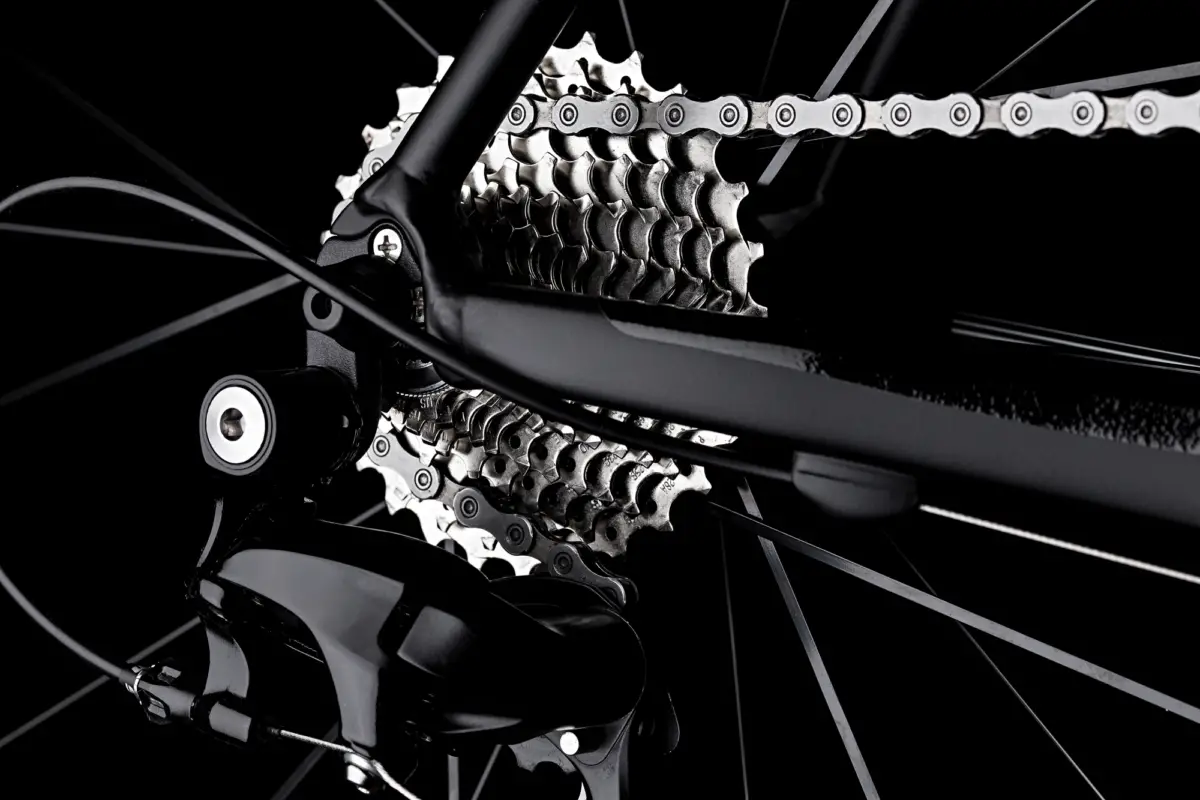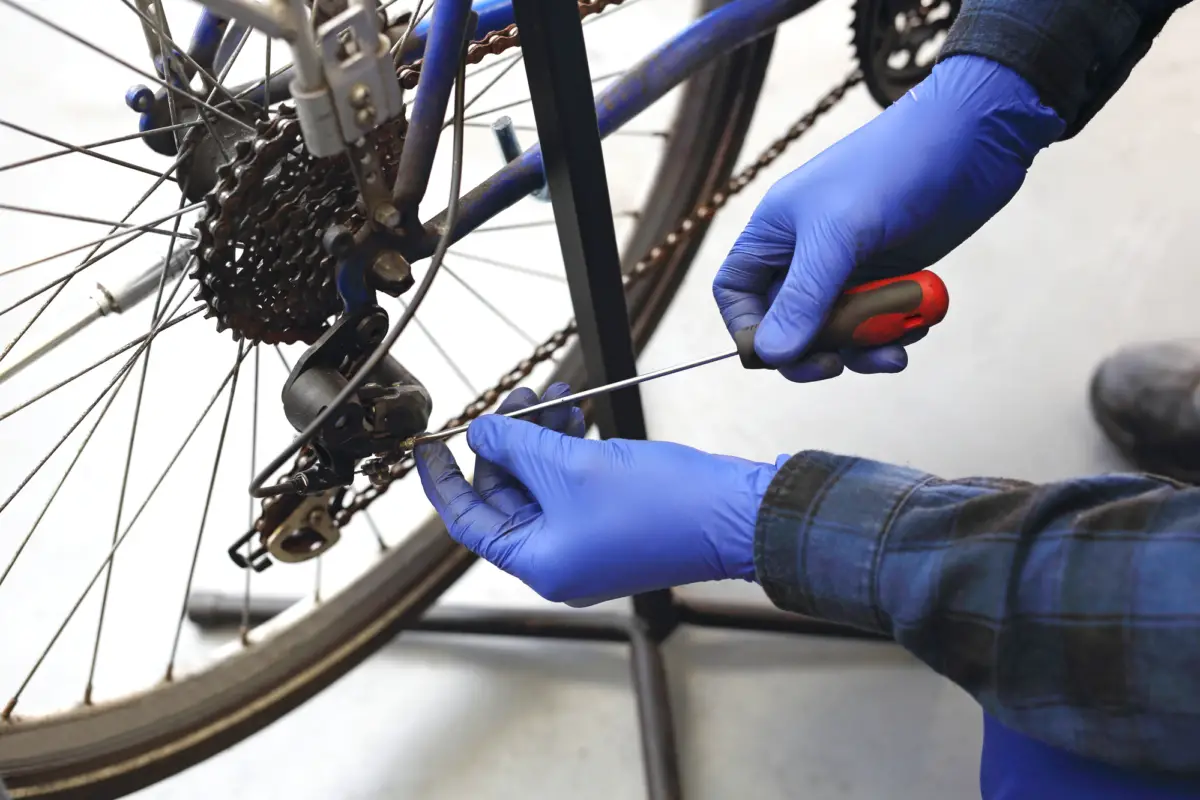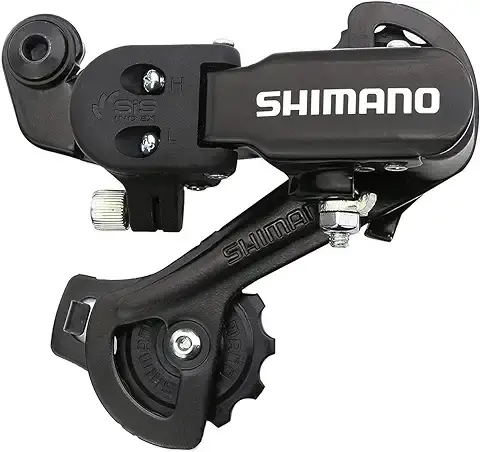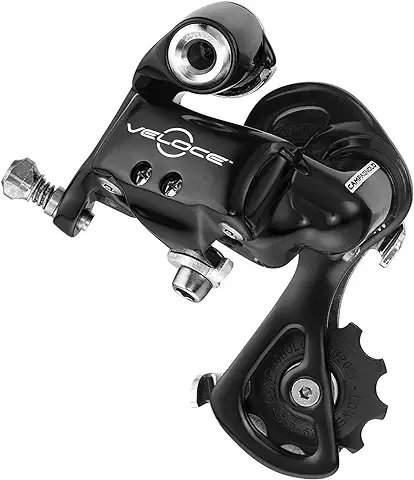Ever found yourself asking, “What is a derailleur on a bike?”. You’re not alone. A derailleur on a bike may seem small, but it can make your ride much easier.
Imagine this: you’re cycling uphill and feeling the strain in every muscle. With one flick of your fingers, that daunting incline becomes a manageable task. Why? Because that little gadget – yes, the derailleur – smoothly shifts gears and eases your effort.
In essence, derailleurs are like maestros conducting an orchestra – orchestrating seamless gear changes while keeping everything in harmony. But what happens when there’s discordance? What if shifting feels more like grinding?
With the know-how to shift gears smoothly and efficiently. No more jumbled rides, just seamless cycling enjoyment awaits you!
Table of Contents
Table Of Contents:
- Understanding the Basics of a Derailleur on a Bike
- Types of Derailleurs for Different Bikes
- Adjusting Your Bike’s Derailleur for Optimal Performance
- Understanding Gear Ratios and Chain Capacity
- Maintenance and Care for Bike Derailleurs
- Comparison of Different Derailleur Brands and Models
- Upgrading or Replacing Your Bike’s Derailleur
- Exploring Advanced Features and Innovations in Bike Derailleurs
- FAQs in Relation to What is a Derailleur on a Bike
- Conclusion
Understanding the Basics of a Derailleur on a Bike
If you’ve ever wondered, “What is a derailleur on a bike?” you’re not alone. The rear derailleur, secured to your bike with a mounting bolt to the frame’s derailleur hanger, plays an essential role in how your bike functions.
How Derailleurs Work
The basic design of this nifty component allows it to move the chain across different sprockets or cogs when shifting gears. When it comes down to brass tacks, that’s what makes gear changing possible.
A simple twist or push of your handlebar-mounted shifter pulls or releases tension in the cable connected to your rear derailleur. This action moves its guide pulley up and down along your cassette (that cluster of gears near your back wheel).
Moving upwards towards smaller cogs lets you pedal easier for climbing hills; conversely moving downwards toward larger ones helps keep speed while pedaling less – handy for flat roads and descents. It’s like magic but without any rabbits pulled from hats.
The Components at Play: More Than Meets The Eye
Besides facilitating smooth transitions between different-sized cogs, there are several other components working together behind-the-scenes within each mechanism.
- Your limit screws help avoid disaster by stopping overzealous shifts which could throw chains into spokes or frames.
- Jockey wheels guide chains seamlessly through changes in direction and maintain correct chain tension regardless if you’re shifting up or down gears.
The next time someone queries about derailleurs, you’ll be ready to provide them with the fundamentals of how they operate. Remember, the art and science of gear shifting lies in the small details – from the tension on your cables to those tiny limit screws. So here’s to smoother rides and fewer wrong-gear woes.
Types of Derailleurs for Different Bikes
Different types of bikes often require unique derailleurs. For instance, a mountain bike derailleur, with its rugged design and clutch mechanism, is made to handle the demands of off-road cycling. The clutch helps limit the movement of the derailleur cage, preventing chain drops on rough terrains.
On another hand, road derailleurs are built lighter and sleeker to optimize speed and efficiency on paved surfaces. And then there’s gravel derailleurs which strike a balance between durability and weight – designed specifically for mixed-terrain rides where you might find yourself switching from asphalt roads to gravel paths frequently.
Rear Derailleur Types: A Closer Look
A key factor differentiating these types is tooth capacity – how much chain slack it can take up while shifting across gears. Mountain bike derailleurs typically have larger tooth capacities than road ones due to wider gear ranges in mountain biking.
In terms of design specifics though, Shimano introduced electronic shifting systems like Di2 that bring high precision shifts without cable stretch or wear over time into their higher-end road groupsets,. SRAM has also rolled out their AXS line featuring both mechanical (cable actuated) and electronic options depending upon rider preference.
Finding Your Perfect Match
The type of derailleur best suited for your ride depends not just on your bike but also riding style, terrain preferences as well as personal choice in maintenance needs. This detailed comparison can help you find the perfect match. Remember, derailleur adjustments and maintenance are also key to ensure smooth gear shifts and a great ride.
To conclude, derailleurs may appear insignificant but they are a critical factor in your bike’s operation. So understanding their types is not just about knowing parts of your bike better but taking a step towards improved cycling experience.
Adjusting Your Bike’s Derailleur for Optimal Performance
Optimizing your bike derailleur is essential to ensure seamless gear shifting and an enjoyable ride. A well-adjusted derailleur ensures precise shifting, allowing you to change gears with ease.
Step-by-Step Instructions for Adjusting Your Derailleur
The first step is getting familiar with the components of your derailleur. Key elements include limit screws that control how far the derailleur moves inwards or outwards, and a barrel adjuster which adjusts cable tension.
To start adjusting, shift into the smallest chainring at the front and biggest sprocket at the back. This will allow easy access to both high and low limit screws on most derailleurs. Begin by tweaking these until they are correctly set up to avoid any possible contact with the spokes of the rear wheel when changing gears. Here’s an excellent guide on how to get it done right.
The next part involves fine-tuning cable tension using barrel adjusters until gear changes become seamless without delay or noise. Remember that patience is key here as even quarter turns can make noticeable differences.
Common Derailleur Issues and How To Fix Them
Sloppy shifting could be due to various reasons like worn-out jockey wheels or stretched cables (cable stretch). Both are easily fixable – simply replace old parts or tighten slackened cables respectively.
A skipping chain often indicates incorrect adjustment of either the high limit screw preventing full engagement with the largest cog, the low limit screw causing issues reaching the smallest cog, or poor alignment from a bent hanger impacting the aft movement of the derailleur cage – yes, bikes need alignments too. So, make sure to get that fixed.
Chain rub against the derailleur cage is another common issue. This usually signifies an incorrect angle of the derailleur or issues with limit screws and can be resolved by realigning the derailleur and adjusting these screws as necessary.
Understanding Gear Ratios and Chain Capacity
The world of cycling can sometimes seem as complex as it is exhilarating. Take gear ratios and chain capacity, for instance. Comprehending these terms is critical for mastering your ride.
A bike’s gear ratio relates directly to how hard or easy it is to pedal. It’s calculated by dividing the number of teeth on your front chainring by those on a rear cassette cog – simple math that has profound implications for performance.
To illustrate this concept, imagine pedaling uphill with a low gear ratio; you’d find it much easier because each rotation requires less effort but moves you a shorter distance. Conversely, higher ratios mean more effort per rotation but cover more ground – ideal when speed matters.
Gearing Up: The Role of Derailleurs in Determining Gear Ratios
Your derailleur plays an essential role here too. By moving the chain across different sprockets (a.k.a cogs), derailleurs allow you change gears mid-ride – effectively altering your gear ratio according to terrain conditions and personal preference.
Caging Your Expectations: Understanding Chain Capacity
Chain capacity, meanwhile, refers specifically to what extent a derailleur can handle changes in gearing without causing issues such as slack or tension in the chain.This largely depends upon two factors:
- The size difference between largest and smallest cogs at both ends i.e., ‘front range’ + ‘rear range’
- The length of the cage which determines how much excess chain it can take up during shifts between larger/smaller gears.
Note: Bigger differences in gear sizes require derailleurs with longer cages and higher total drivetrain capacity.
As an avid cyclist, understanding these concepts has helped me improve my riding experience significantly. So whether you’re a seasoned rider or just starting out on your cycling journey, getting to grips with gear ratios and chain capacities is definitely worth the pedaling effort.
Maintenance and Care for Bike Derailleurs
Maintaining your bike’s derailleur in optimal condition is essential for a pleasurable cycling experience. This involves regular cleaning, lubrication, and inspections.
Cleaning Your Bike Derailleur
A clean derailleur ensures seamless gear shifting. Get a soft brush to scrub off grime from the jockey wheels and the derailleur cage. Remember, mechanical-type derailleurs use a cable secured at a pinch bolt; make sure it’s not compromised during cleaning.
You can also soak parts like the chain in degreaser solutions but be careful not to get any on your disc brake pads or rotors as this could reduce braking performance.
Lubricating Your Bike Derailleur
Once you’ve cleaned all parts thoroughly, apply some bike-specific lube on pivot points of the rear derailleur where movement occurs. The idea here is that good lubrication helps minimize wear and tear over time while reducing friction when changing gears.
Inspecting Your Bike’s Parts Regularly
An inspection routine will help spot potential issues before they become serious problems – something particularly crucial if you’re heading out for long rides regularly. Pay special attention to signs of wear such as worn-out teeth on jockey wheels or bends in the derailleur hanger.
Prompt Replacement of Worn-Out Parts
If there are signs of excessive wear after inspecting these components then it may be time for replacements. Replacing worn-out parts promptly extends overall drivetrain life and maintains optimal cycling performance – especially important with integral components like jockey wheels which guide chains across sprockets.
Preventing Damage during Transportation or Crashes
Bike derailleurs can be delicate. During transportation, consider removing the derailleur to prevent any damage from accidental knocks. In case of crashes, inspect your bike thoroughly and address issues immediately – this might just save you from costlier repairs down the line.
Comparison of Different Derailleur Brands and Models
If you’re seeking to upgrade your bike’s gear shifting performance, it’s important to know the differences between various derailleur brands and models. Let’s explore some popular ones.
 Shimano Derailleurs
Shimano Derailleurs
Shimano has been a mainstay in the cycling world since introducing their first derailleur back in 1956. They introduced their first derailleur back in 1956 and have continued innovating since then. Today, they offer an extensive range from entry-level derailleurs for casual riders to high-end versions for professional cyclists.
A notable feature across many Shimano models is their Di2 electronic shifting system. This allows precise control over gear changes with minimal effort on part of the rider (source). The only drawback might be that these systems require regular charging.
 SRAM Derailleurs
SRAM Derailleurs
Moving onto SRAM, this company shook up the market by introducing a wireless electronic groupset called eTap AXS (source). With no need for cables or wires, installation becomes easier while maintaining excellent shift quality. However, like any advanced tech, it does come at a premium price point.
 Campagnolo Derailleurs
Campagnolo Derailleurs
Last but not least are Campagnolo derailleurs which bring Italian craftsmanship into every component they make including derailleurs.Their Super Record series stands out with its carbon fiber construction reducing weight without compromising durability source.
Before deciding, consider your riding style, budget and technical needs. Whether it’s the long-established reputation of Shimano, SRAM’s cutting-edge technology or Campagnolo’s superb craftsmanship, each brand has unique offerings that could be a perfect match for you.
Upgrading or Replacing Your Bike’s Derailleur
The derailleur is the heart of your bike’s gear changing system. Over time, the derailleur’s performance can deteriorate and necessitate an upgrade or replacement.
Signs That It’s Time for a Change
If you’re constantly dealing with sloppy shifting or if the derailleur doesn’t move smoothly across sprockets anymore, it might be time to consider replacing your bike’s derailleur. You may also notice that even after adjusting the limit screws and cable tension properly, your gears aren’t working as they should – another telltale sign that an upgrade could help.
Rear derailleurs have improved significantly in recent years with innovations like electronic shifting and clutch mechanisms offering more precise control. So upgrading from a traditional mechanical-type model to something newer like Shimano Di2 or SRAM AXS can give your ride a significant boost.
Finding Compatible Derailleurs
You need to ensure compatibility when upgrading or replacing your bike’s derailleur. The type of drivetrain (number of speeds), frame design (derailleur hanger), chainring sizes, largest cog on the rear cassette – all these factors influence which models will work best for you.
Your new rear derailleur must match the number of gears in your setup – so if you’re running 11-speed road groupsets on a road bike; make sure not to get one designed for 12-speed mountain bikes. And remember: some modern single-chainring setups may require derailleurs specifically designed for them.
A Step-by-Step Guide To Replacement
Here’s our guide to get you started with replacing your bike’s derailleur. It starts from removing the old one, installing the new unit and adjusting it for optimal performance.
Whether you’re a long-time cyclist or just starting out, don’t be intimidated by this task. With some basic tools and a little patience, upgrading or replacing your bike’s derailleur can be an enjoyable DIY project that will make your rides more efficient and fun.
Exploring Advanced Features and Innovations in Bike Derailleurs
In the realm of cycling, technology is continuously developing. This evolution isn’t limited to just frame materials or tire design; it extends to even seemingly small components like derailleurs. Recent advancements have made possible features that were inconceivable a few years back.
The Advent of Electronic Shifting
Shimano introduced electronic shifting with their Di series, changing how we perceive gear changes forever. These systems use electronically controlled derailleurs for lightning-fast shifts, making sure you’re never stuck in the wrong gear again.
Sram took this concept further with its AXS groupsets, which feature wireless connectivity between shifters and derailleurs. Now there’s no need to worry about cable stretch or housing maintenance.
Clutch Mechanisms: The Game Changer for Off-Road Cycling
Moving on from road groupsets, mountain bikes also saw significant advancements thanks to clutch derailleur mechanisms. Clutch derailleurs help maintain chain tension over rough terrain by restricting aft movement of the derailleur cage, thus preventing chain slap and drops – crucial factors when navigating technical trails.
The Rise of Single Chainring Setups
An increasing number of cyclists are switching out their double or triple front setups for single chainrings – another major innovation in recent years. With modern rear cassettes offering up large sprockets (the largest cog), riders can get comparable range without having multiple front rings complicating things.
Ease of Adjustment: The Quarter Turn Revolution
Adjusting derailleurs used to be a chore, but thanks to modern designs with features like quarter turn limit screws and easy-to-access barrel adjusters, it’s never been easier. This allows cyclists to fine-tune their gear shifting for smooth transitions between the smallest sprocket (highest gear) and largest cog (lowest gear).
What’s Next in Derailleur Tech?
The future is promising when it comes to derailleur technology. As more companies enter the fray with new ideas, we can expect even better performance from our bike gears.
FAQs in Relation to What is a Derailleur on a Bike
What does a derailleur do on a bike?
A derailleur’s job is to move the chain between different gears. It lets you shift smoothly, matching your pedaling effort with varying terrain.
What does a derailleur on a bike look like?
The typical bicycle derailleur has two jockey wheels that guide the chain, an arm that swings side-to-side, and springs for tension. Its form can vary by type and brand.
Can I ride my bike without a derailleur?
Sure, but only if it’s set up as single-speed or fixed-gear. Without derailleurs though, changing gears won’t be possible which limits flexibility when tackling hills or high speeds.
Why do you need a derailleur?
You need derailleurs for gear shifting while riding – they let cyclists adjust their pedal power efficiently across diverse terrains from flat roads to steep climbs.
Conclusion
Now you know the mystery of a bike’s derailleur and its importance for your biking experience. You’re ready to conquer any terrain with confidence.
Remember, not all derailleurs are created equal – they come tailored for road bikes, mountain bikes or gravel bikes. Adjusting your bike’s derailleur is key to smooth gear shifting; get familiar with limit screws and cable tension.
Maintenance isn’t just about cleaning; it involves regular inspection and timely replacement of parts like jockey wheels. Know when an upgrade or replacement becomes necessary by keeping an eye out for signs of wear-and-tear.
You’re more than equipped now to handle that uphill climb or speed along flats effortlessly! Here’s wishing you many seamless rides ahead!




 SRAM Derailleurs
SRAM Derailleurs